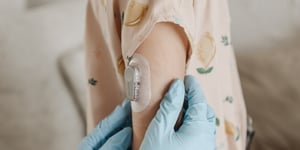You’ve reached the product development phase and are looking for material: congratulations! Now it’s time to cover your eyes and press order on the first tape you see online… or not.
Although the advertisements on the first page tempt you, you’re also aware that quality demonstrates itself best through proof of concept. Strouse has filled hundreds of orders with stick-to-skin applications, but we’re always looking for new materials and ways to process stick-to-skin adhesives for maximum effectiveness.
Before you read our recommendations, we’ll review the primary types of stick-to-skin tapes and explain how to choose the right skin adhesive for you.
Which Adhesive Tapes Can You Use on Skin?
While duct tape is excellent at holding down tarps, it’s not the most reassuring material to see in a skincare kit or an operating room.
Nowadays, manufacturers build tapes explicitly meant for skin applications. These materials lend themselves to the converting process and have been through rigorous testing to ensure their composition and capabilities are well-documented.
For the safety of your loyal customers or patients, it’s essential to research the material that will work best for you. Let’s take a quick look at the two main types of skin adhesives to give you an idea of what you’re looking for before inspecting specific products. Of course, there are other materials out there that you might want to consider—like rubber or hydrocolloid—acrylic and silicone are just the most commonly used.
SILICONE SKIN ADHESIVES
Silicone skin adhesives typically form weaker adhesive bonds that are ideal for delicate/fragile skin and repositionable applications.
Elderly, children, diabetic patients, or anyone with pre-existing skin conditions can benefit from malleable silicone skin adhesives that prevent tearing. Silicone skin adhesives are also considered biocompatible because they don’t tend to cause harm.
Unfortunately, silicone adhesives can also be more expensive, and they don’t always have enough holding power to handle what you attach.
ACRYLIC SKIN ADHESIVES
Acrylic skin adhesives are often stronger than silicone and hold more weight at a lower cost.
While silicone skin adhesives are used for light fixings or gentle cosmetic purposes, acrylic skin adhesives can hold wearable devices such as glucose monitors.
We’re about to look at a range of materials, so keep the differences between silicone and acrylic adhesive in mind as you search for a material.
7 of the Best Stick to Skin Tapes
As we all know, “best” is subjective, so what makes these seven tapes better than any others?
Strouse has processed most of these materials in large-scale projects, running them through our machines and cutting them with standard die cut tools to observe their performance.
To make a fair comparison today, we’ve compiled public data about the tape’s material composition, test results, and other information regarding each tape. Our list is organized from tape that covers general stick-to-skin applications to more specific uses.
This article isn’t sponsored: it’s a compilation of products Strouse has worked with throughout the years and found especially useful to our projects.
#1: 3M MEDICAL SILICONE TAPE 2476P
Adhesive type: Silicone
Material: Single-sided white spunlace polyester nonwoven
Gamma or EtO sterilizable?: EtO
Highlights:
- Clear non-silicone release liner
- Flexible and conformable
- Doesn’t pull hair
3M’s 2476P medical silicone is a breathable, repositionable, and fluid-resistant adhesive tape. This adhesive is actually used in several constructions depending on the use case. It is the most widely used adhesive in stick-to-skin applications.
It’s an excellent choice for general medical applications requiring breathability, device attachment to skin, general taping to fragile skin, healthcare or medical device construction, and cover tape for finished device.
#2: AVERY DENNISON MED 5707
Adhesive type: Acrylic
Material: Single-coated white spunlace nonwoven
Gamma or EtO sterilizable?: Yes (both)
Highlights:
- Conformable and breathable
- Moisture resistant
- Heat-sealable
If you’ve been keeping up with Strouse’s blogs, there’s a slight chance you’ll recognize this tape from the #5 slot on our wound dressing tape ranking.
Avery Dennison’s MED 5707 is an all-around, breathable tape with an acrylic adhesive for medical applications. The overall tape has a storage and shelf life of about two years when stored at the recommended conditions.
While it managed to rank on our ranking for best wound dressing tape, MED 5707 also functions exceptionally well in situations other than wound dressing, such as fixing devices in electromedical, ostomy, and other wound care applications.
#3: 3M MEDICAL TAPE 1526
Adhesive type: Tackified acrylic
Material: Single-sided, surface-treated polyethylene film
Gamma or EtO sterilizable?: Yes (both)
Highlights:
- Printable and flexible
- Translucent with a matte finish
- Fluid resistant
- Heat-sealable
3M Medical Tape 1526 is a tackified acrylic adhesive with a polyethylene film coated on one side and a pressure-sensitive acrylic adhesive. Although this adhesive tape is labeled as medical, you can use it in a wide variety of applications in fields such as healthcare devices or cosmetic adhesives.
Medical tape 1526 has many properties, including a liquid barrier that gives it its fluid resistance. It was specifically developed for skin contact.
#4: MACTAC TM8101
Adhesive type: Highly-breathable acrylic
Material: Single-coated white spunlace nonwoven fabric
Gamma or EtO sterilizable?: EtO, gamma, and autoclave
Highlights:
- Breathable
- Allows moisture vapor transmission
- Comfort and conformability
Mactac’s TM8101 is used in long-term applications where moisture vapor transmission is desired.
TM8101 is intended for 3-5 days of wear with good adhesion. The fabric is resistant to aqueous solutions and has a two-year shelf life when stored in the recommended conditions.
This material is typically used in electrode and sensor construction, ostomy, wound dressings, fixation devices, device coverings, and surgical garments.
#5: AVERY DENNISON MED 5634
Adhesive type: Acrylic
Material: Single-coated EVA foam
Gamma or EtO sterilizable?: Yes (both)
Highlights:
- Relatively thick
- Heavy-duty liner with an easy release
Avery Dennison’s MED 5634 is designed for mounting electrodes, grounding pads, and other devices for periods of time.
MED 5634 is a powerful adhesive that resists moisture and forms a strong bond to the skin despite any stress conditions. The thick foam tape has a high initial tack, allowing it to withstand stress and hold up wearable devices.
This material was designed for mounting electrodes and grounding pads for sustained periods.
#6: 3M MEDICAL TAPE 4576
Adhesive type: Extended wear acrylate
Material: Single-sided white spunlace polyester nonwoven
Gamma or EtO sterilizable?: EtO
Highlights:
- Paper-based silicone release liner
- Flexible and conformable
- Excellent adhesion to low surface energy materials
Another top contender for both our wound dressing tape ranking and the stick-to-skin list is 3M Medical Tape 4576, which uses a strong, pressure-sensitive acrylic adhesive for long-term wear applications.
3M Medical Tape 4576 has up to 21 days of wear time on the skin. Suggested medical or retail applications for this product include attaching finished devices to the skin for extended periods or constructing different devices.
#7: AVERY DENNISON MED 5720P
Adhesive type: Porous acrylic
Material: Single-coated tan embossed polyester nonwoven
Gamma or EtO sterilizable?: Yes (both)
Highlights:
- Breathable and conformable
- Heat-sealable
If you’re looking for a more specific application, Avery Dennison’s MED 5720P is primarily designed for and used in ostomy applications.
MED 5720P is a porous acrylic adhesive made from a tan, embossed polyester nonwoven material. The material's porous nature allows air and moisture through the adhesive and nonwoven carrier, creating a breathable environment to reduce skin damage caused by maceration.
Which Adhesive Skin Tape Should I Use?
Your choice of adhesive skin tape should reflect the needs of your product. Ask yourself the following questions about your product:
- How long does your product need to stay fixed to the skin?
- Will this product be used on individuals with potentially sensitive skin (injured, diabetic, children, or elderly)?
- Does it need to hold any devices or tubes?
-
- What are they made out of?
- How heavy will they be?
These are all questions converters should ask you while you create your skin adhesive product.
Before you start filling up your cart, remember supplying your own material can cause issues. That’s why you should always consult your converter about the chosen material to ensure it’s a good match.
Ideally, you want to avoid dealing with the frustration of making design or material changes down the road. Instead of waiting to stumble upon problems with your initial product design, get a quote on your design today so an experienced converter can help you with your project solution.
Originally published: March 15, 2023







